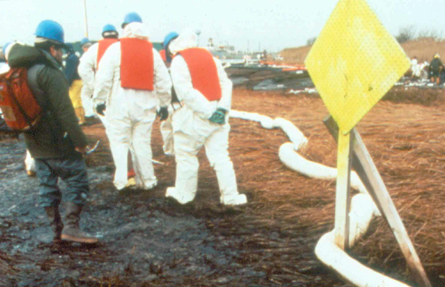Exxon Bayway
Oil Spill | Linden, New Jersey | January 1990
What Happened?
On January 1 and 2, 1990, #2 fuel oil spilled from the Exxon Bayway facility’s underwater pipeline in Linden, New Jersey. Approximately 567,000 gallons were released directly into the Arthur Kill, a saltwater channel between New Jersey and Staten Island.
NOAA joined the U.S. Coast Guard on-scene, responding to the spill within hours. Along with other federal, state, and local agencies, we helped to identify resources at risk; conducted overflights, shoreline surveys, and mapping; and recommended appropriate cleanup techniques.
What Were the Impacts?
The oil blanketed more than two thousand acres of fish and wildlife habitats, including open water, tidal marshes, and backwater creeks, and over 200 acres of tidal salt marsh on Staten Island and in New Jersey. The oiling smothered fish, crabs, and clams, and caused massive losses of salt marsh cordgrass (Spartina alterniflora) in some wetlands. The oil also directly killed an estimated 700 waterbirds.
What’s Happening Now?
NOAA worked with the other natural resource trusteesGovernment officials acting on behalf of the public when there is injury to, destruction of, loss of, or threat to natural resources. to conduct a natural resource damage assessment (NRDA)Investigation performed by trustees to identify injuries to natural resources caused by oil spills, hazardous substance releases, and grounding incidents in National Marine Sanctuaries, and plan restoration activities. The goal of NRDA is to restore natural resources and compensate the public for lost recreational use.. The NRDA process included quantifying the injuries to natural resources, including recreational losses, associated with the spill, and determining the amount and type of restoration required to compensate the public for those losses.
In 1991, Exxon Corporation, the owner and operator of the Bayway Linden facility, agreed to pay over $11.5 million in civil damages and criminal penalties during ongoing litigation. NOAA worked with the other trustees to ensure that these funds were used in accordance with the terms of the settlement agreement. To date, 111 acres of marsh habitat have been enhanced or restored, and more than 80 acres have been acquired for protection. Restoration work is ongoing.
“The Arthur Kill waterway and environs were largely unnoticed until seven species of waterbirds were found nesting on local islands in the 1980s. The backwater of one of America’s largest industrialized corridors hosts some of the nation’s greatest treasures in the form of a near secret urban wilderness that is impressive in its diversity and natural beauty.“
-- Carl Alderson, NOAA Marine Resources Specialist
Contacts
Carl Alderson
Marine Resources Specialist
NOAA Restoration Center
Highlands, NJ
(732) 371-0848
Carl.Alderson@noaa.gov








